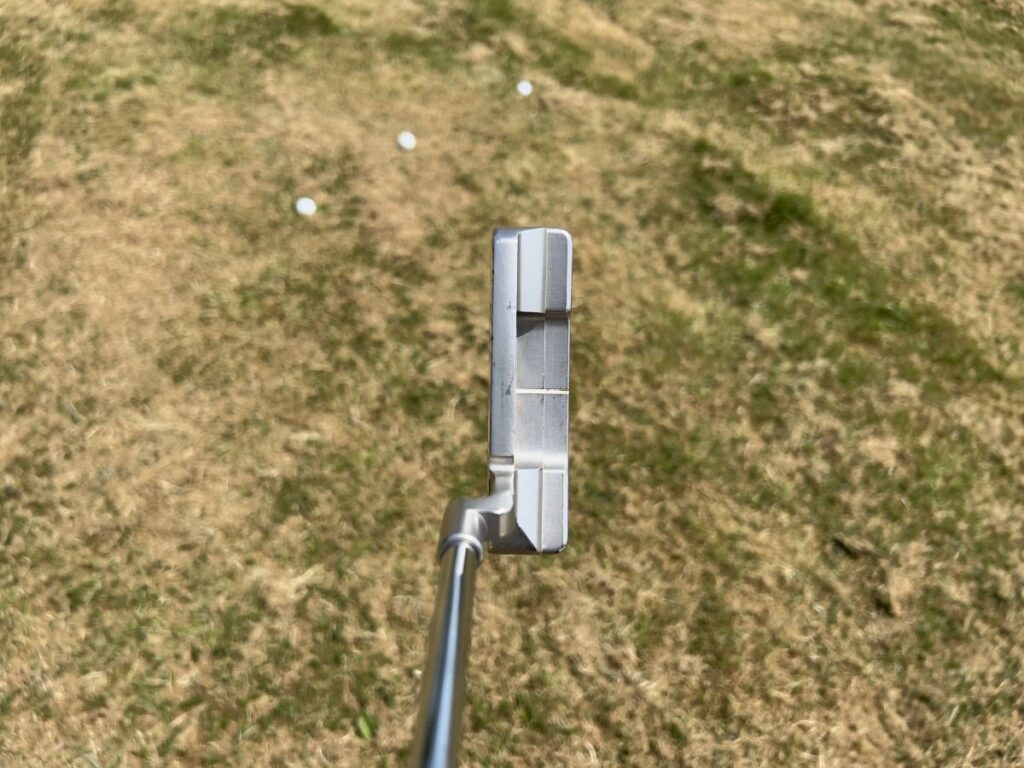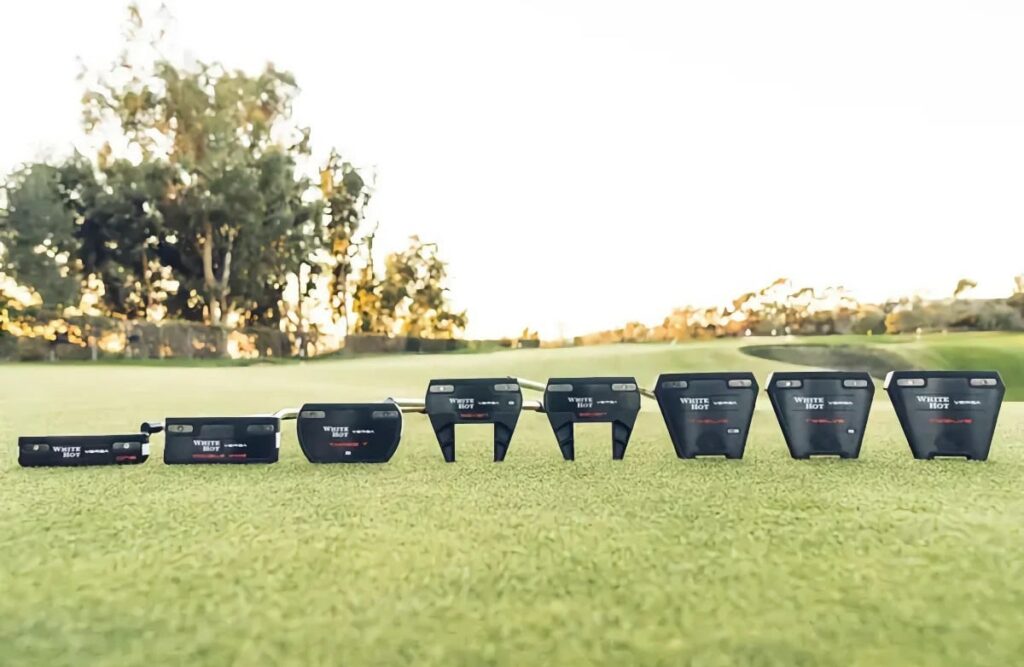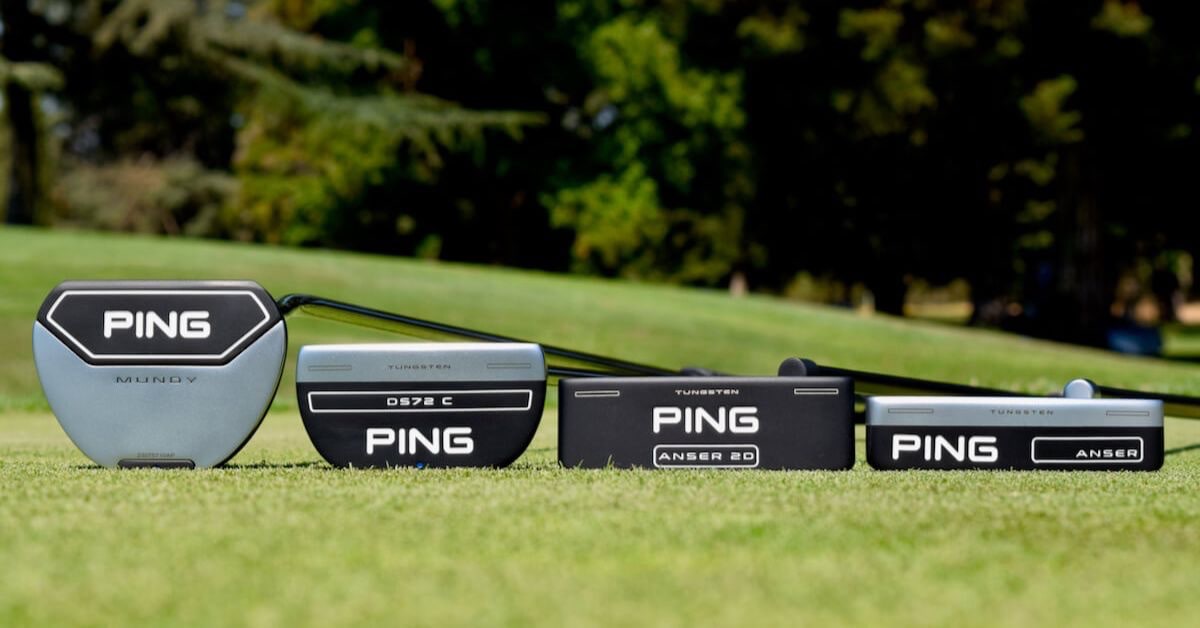Years ago, you were considered a “better golfer” if you used a blade putter.
You can now throw that concept out the window!
The blade vs mallet putter debate is not about your ability to putt — but it has everything to do with performance and personal preference.
“Putters are personal.”
Scotty Cameron
In this article, I’ll show you the pros and cons of a blade vs mallet putter to help you decide which one is likely to be the better fit for your golf game.
And even though I’m a blade person myself, some of the new mallet putters out there seriously rival the performance!
Blade vs Mallet Putter
Blade putters have a traditionally small head design, often featuring a short alignment line and a rectangular and compact shape. Mallet putters have a much larger head shape, which distributes weight further back. Ultimately, mallet putters are more forgiving by offering high MOI, consistent speed, and more space for alignment.
What Is a Blade Putter?

The blade putter is the traditional putter type that has been used for decades. With a classic and simple rectangular shape, it’s designed to maximize feedback and feel on the greens without causing any distraction. Often, blade putters have offset which helps to encourage a slight arc stroke.
When I first started teaching golf, blade putters were not nearly as forgiving. This has changed, and now there are blade putter options regardless of your handicap.
I play with a blade putter; my favorite thing is the feedback and feel. When using the blade, I know I’m in charge. And if I missed a putt, it was my fault, not the putter’s.
I guess that’s a little harsh, but it’s helped me to keep my putting game where I want it!
Pros
- Classic look and feel
- Streamlined design
- A great option for an arc style putting stroke
- Lots of feedback on good and bad putts
Cons
- Not a large sweet spot
- Need to make sure they have enough weight in the head
What Is a Mallet Putter?

Mallet putters have a significantly larger head shape, which pushes the center of gravity further back in the head. Due to the larger size, mallet putters are generally heavier than blades. Essentially, this helps to stabilize the putting stroke, enabling you to start more putts on your target line.
When the first modern mallet putters started coming to the market, we used to joke that they looked like a shoebox on a stick!
There’s no question that mallets have a large design, but that can play to your benefit.
The oversized club head is heavier, has a larger sweet spot, and impressive feel. In short, this can make it easier for golfers that use a straight-back, straight-through putting stroke to keep the club stable throughout the action.
Pros
- Easy to line up
- Helps keep the putter stable at impact
- Can keep the putter on line both back and through
- Usually has plenty of weight in the clubhead
Cons
- Large designs can throw players off at first
- Not always the best for arc style putting strokes
Differences Between Blade vs Mallet Putters

In my opinion, it’s best to choose a blade or mallet putter based on your personal preferences and your style of putting stroke.
With some of the recent putters I tried, I’ve been surprised by how the differences between blade and mallet putters are becoming less noticeable.
That said, there are important differences to be aware of. Let’s dive into them!
Weighting
At first glance, it seems as though all mallet putters would be heavier than blades.
With the oversized shape, mallets are usually made with more material. However, that material can be lightweight and often hollow depending on the brand.
Conversely, most blade putters are milled from a single piece of metal. With a solid construction, that can add lots of weight to the head despite the smaller size.
Overall, the putter’s total weight must consider the shaft, clubhead, and even the grip.
Ultimately, heavy putters do well on fast greens as you can rely on gravity to guide the putting stroke. On the other hand, lighter putters are a better choice for slow greens as it forces you to rely on your natural feel when gauging distance control.
Accuracy
In recent times, launch monitor technology has taught us so much more about accuracy in putting and how the smallest differences can make the biggest impacts.
To have consistent success with your putter, it must match your stroke. Also, it has to have enough forgiveness for the inconsistencies in your putter’s delivery.
For the most part, mallet putters have a higher MOI with a bit more forgiveness.
Blade putters intentionally have less forgiveness to improve overall feel and feedback.
If you miss a putt with a blade, you will know it. Your putting performance may suffer until you fix the issue. More accurate golfers should consider the blade.

Forgiveness
Recently, I’ve come to realize that the main difference in forgiveness between the blade vs mallet putter is whether they are traditional or more modern putters.
In recent years, golf manufacturers have found ways to add MOI to their putter heads regardless of the clubhead shape. Effectively, blade putters used to be a block of metal on the end of the shaft. Today, there’s more in-built technology to aid forgiveness.
When choosing a putter, pay close attention to the weight distribution in the putter head if you struggle with missing your putts left or right.
If you tend to miss putts left, go for a putter with a bit more toe hang. This will help square up the clubface through impact, starting the ball on a straighter line.
Feedback and Feel
Most of the time, choosing a golf club should also come down to feel.
I have always felt as though a mallet putter has more of a stable feel at impact.
Pay close attention to the putter face insert, as this will have an impact on feel. Many mallet putters have an insert as they are made using a combination of materials.
Ultimately, putting with a blade can feel more like an art, whereas a mallet feels more mechanical and rigid because it can do a lot of the work for you.
Alignment
Mallet putters are often easier to align with the ball because they have longer alignment lines on the top of their putter heads — due to the larger space to work with.
However, not all players need help with alignment. If you typically putt more on feel than on mechanics, the extra alignment line may not be something you are missing.
Check out the video below by MyGolfSpy, which compares the blade vs mallet putter types to help you decide which one fits your stroke:
How to Choose the Right Putter For Your Game
When choosing a putter, I would start by looking at your putting stroke.
For those golfers with an arc-style putting stroke, a blade putter is best for you. If you have a straight-back and straight-through stroke, mallets are the better choice.
However, I’ve seen plenty of great players choose their putter based entirely on feel, regardless of the putting stroke they use.
In 2020, Golf.com analyzed which putter types were used by the top 50 players in Strokes Gained Putting on the pro tour. The study found that 60 percent of golfers used mallets, while the other 40 percent used blades — pretty close to an even split.
Ultimately, the short game is personal. If you’ve been struggling on the greens recently, consider changing the putter head shape. Who knows, it might reverse your fortunes!


